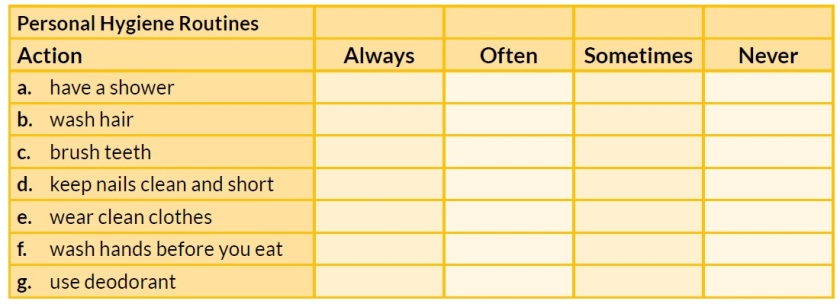PRESENT SIMPLE TENSE
(Source: https://www.grammar.cl/Present/Simple.htm)
The simple present tense in English is used to describe an action that is regular, true or normal.
We use the present tense:
1. For repeated or regular actions in the present time period.
- I take the train to the office.
- The train to Berlin leaves every hour.
- John sleeps eight hours every night during the week.
2. For facts.
- The President of The USA lives in The White House.
- A dog has four legs.
- We come from Switzerland.
3. For habits.
- I get up early every day.
- Carol brushes her teeth twice a day.
- They travel to their country house every weekend.
4. For things that are always / generally true.
- It rains a lot in winter.
- The Queen of England lives in Buckingham Palace.
- They speak English at work.
Verb Conjugation & Spelling
We form the present tense using the base form of the infinitive (without the TO).
In general, in the third person we add 'S' in the third person.
| Subject | Verb | The Rest of the sentence |
|---|
| I / you / we / they | speak / learn | English at home |
| he / she / it | speaks / learns | English at home |
The spelling for the verb in the third person differs depending on the ending of that verb:
1. For verbs that end in -O, -CH, -SH, -SS, -X, or -Z we add -ES in the third person.
- go – goes
- catch – catches
- wash – washes
- kiss – kisses
- fix – fixes
- buzz – buzzes
2. For verbs that end in a consonant + Y, we remove the Y and add -IES.
- marry – marries
- study – studies
- carry – carries
- worry – worries
NOTE: For verbs that end in a vowel + Y, we just add -S.
- play – plays
- enjoy – enjoys
- say – says
Negative Sentences in the Simple Present Tense
To make a negative sentence in English we normally use Don't or Doesn't with all verbs EXCEPT To Be and Modal verbs (can, might, should etc.).
- Affirmative: You speak French.
Negative: You don't speak French.
You will see that we add don't between the subject and the verb. We use Don't when the subject is I, you, we or they.
- Affirmative: He speaks German.
Negative: He doesn't speak German.
When the subject is he, she or it, we add doesn't between the subject and the verb to make a negative sentence. Notice that the letter S at the end of the verb in the affirmative sentence (because it is in third person) disappears in the negative sentence. We will see the reason why below.
Negative Contractions
Don't = Do not
Doesn't = Does not
I don't like meat = I do not like meat.
There is no difference in meaning though we normally use contractions in spoken English.
Word Order of Negative Sentences
The following is the word order to construct a basic negative sentence in English in the Present Tense using Don't or Doesn't.
| Subject | don't/doesn't | Verb* | The Rest of the sentence |
|---|
| I / you / we / they | don't | have / buy
eat / like etc. | cereal for breakfast |
| he / she / it | doesn't |
* Verb: The verb that goes here is the base form of the infinitive = The infinitive without TO before the verb. Instead of the infinitive To have it is just the have part.
Remember that the infinitive is the verb before it is conjugated (changed) and it begins with TO. For example: to have, to eat, to go, to live, to speak etc.
Examples of Negative Sentences with Don't and Doesn't:
- You don't speak Arabic.
- John doesn't speak Italian.
- We don't have time for a rest.
- It doesn't move.
- They don't want to go to the party.
- She doesn't like fish.
Common time expressions used with the present simple tense are:
always, often, generally, normally, usually, sometimes, never …
every day, every week, every year…
(note the time word is in single form, day, not days.)
once a day, twice a week, three times a month…
(then the rest are four times, five times etc. then A and the time period, a month, a year, a century)
in the morning, in the afternoon, in the evening, at night
(we don’t say in the night)
on Mondays, on Fridays…
(when the day is in plural it refers to all Mondays, all Fridays)









